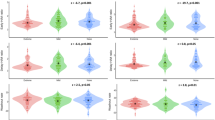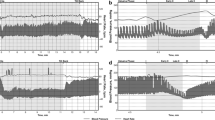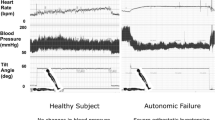Abstract
Purpose
We investigated the effect of levodopa on postural blood pressure changes in individuals with Parkinson disease (PD) with (PD+OH) and without neurogenic OH (PD−OH).
Methods
We performed a prospective randomized crossover study with autonomic testing performed ON and OFF levodopa. The primary outcome was the change in systolic blood pressure (SBP) from supine to 70° tilt at 3 min (ΔSBP-3’). Secondary outcomes included indices of baroreflex function and blood pressure and heart rate during tilt.
Results
We enrolled 40 individuals with PD (21 PD+OH, 19 PD−OH), mean age (SD) 73.2 years (7.9), 13 women (32.5%)). There was no difference in age, sex, disease duration, and severity between PD+OH and PD−OH. Mean difference in ΔSBP-3’ ON versus OFF levodopa in the whole study population was − 3.20 mmHg [− 7.36 to 0.96] (p = 0.14). Mean difference in ΔSBP-3’ was − 2.14 mmHg [− 7.55 to 3.28] (p = 0.45) in PD+OH and − 5.14 mmHg [− 11.63 to 1.35] (p = 0.14) in PD−OH. Mean difference in ΔSBP ON versus OFF levodopa was greater at 7 and 10 min (− 7.52 mmHg [− 11.89 to − 3.15], p = 0.002, and − 7.82 mmHg [− 14.02 to − 1.67], p = 0.02 respectively). Levodopa was associated with lower absolute values of blood pressure in both PD+OH and PD−OH and cardiovascular noradrenergic baroreflex impairment.
Conclusion
Levodopa decreases blood pressure in both PD with and without autonomic failure, but it does not cause a greater fall in blood pressure from supine to standing at 3 min. Levodopa-induced baroreflex sympathetic noradrenergic impairment may contribute to lower blood pressure. Lower standing blood pressure with levodopa may increase the risks of fall and syncope.


Similar content being viewed by others
Data availability
The data that support the findings of this study are available from the corresponding author, GL, upon reasonable request.
References
Jankovic J, Tan EK (2020) Parkinson’s disease: etiopathogenesis and treatment. J Neurol Neurosurg Psychiatry 91(8):795–808
Noack C, Schroeder C, Heusser K, Lipp A (2014) Cardiovascular effects of levodopa in Parkinson’s disease. Parkinsonism Relat Disord 20(8):815–818
McDonald C, Pearce M, Kerr SR, Newton J (2017) A prospective study of the association between orthostatic hypotension and falls: definition matters. Age Ageing 46(3):439–445
Lamotte G, Lenka A (2022) Orthostatic hypotension in Parkinson disease: what is new? Neurol Clin Pract 12(5):e112–e115
Velseboer DC, de Haan RJ, Wieling W, Goldstein DS, de Bie RM (2011) Prevalence of orthostatic hypotension in Parkinson’s disease: a systematic review and meta-analysis. Parkinsonism Relat Disord 17(10):724–729
Hiorth YH, Pedersen KF, Dalen I, Tysnes OB, Alves G (2019) Orthostatic hypotension in Parkinson disease: a 7-year prospective population-based study. Neurology 93(16):e1526–e1534
Nimmons D, Bhanu C, Orlu M, Schrag A, Walters K (2022) Orthostatic hypotension and antiparkinsonian drugs: a systematic review and meta-analysis. J Geriatr Psychiatry Neurol 35(5):639–654
Goldstein DS, Eldadah BA, Holmes C, Pechnik S, Moak J, Saleem A et al (2005) Neurocirculatory abnormalities in Parkinson disease with orthostatic hypotension: independence from levodopa treatment. Hypertension 46(6):1333–1339
Jost WH, Altmann C, Fiesel T, Becht B, Ringwald S, Hoppe T (2020) Influence of levodopa on orthostatic hypotension in Parkinson’s disease. Neurol Neurochir Pol 54(2):200–203
Perez-Lloret S, Rey MV, Fabre N, Ory F, Spampinato U, Senard JM et al (2012) Factors related to orthostatic hypotension in Parkinson’s disease. Parkinsonism Relat Disord 18(5):501–505
Worth D, Harvey J, Brown J, Lee M (1988) The effects of intravenous L-dopa on plasma renin activity, renal function, and blood pressure in man. Eur J Clin Pharmacol 35(2):137–141
Yue JL, Goshima Y, Miyamae T, Misu Y (1993) Evidence for L-dopa relevant to modulation of sympathetic activity in the rostral ventrolateral medulla of rats. Brain Res 629(2):310–314
Reid JL, Calne DB, George CF, Vakil SD (1972) The action of L(-)-dopa on baroreflexes in parkinsonism. Clin Sci 43(6):851–859
Kaufmann H, Norcliffe-Kaufmann L, Palma JA (2020) Baroreflex dysfunction. N Engl J Med 382(2):163–178
Cheshire WP, Freeman R, Gibbons CH, Cortelli P, Wenning GK, Hilz MJ et al (2021) Electrodiagnostic assessment of the autonomic nervous system: a consensus statement endorsed by the American Autonomic Society, American Academy of Neurology, and the International Federation of Clinical Neurophysiology. Clin Neurophysiol 132(2):666–682
Postuma RB, Berg D, Stern M, Poewe W, Olanow CW, Oertel W et al (2015) MDS clinical diagnostic criteria for Parkinson’s disease. Mov Disord 30(12):1591–1601
Gibbons CH, Schmidt P, Biaggioni I, Frazier-Mills C, Freeman R, Isaacson S et al (2017) The recommendations of a consensus panel for the screening, diagnosis, and treatment of neurogenic orthostatic hypotension and associated supine hypertension. J Neurol 264(8):1567–1582
Goetz CG, Tilley BC, Shaftman SR, Stebbins GT, Fahn S, Martinez-Martin P et al (2008) Movement Disorder Society-sponsored revision of the Unified Parkinson’s Disease Rating Scale (MDS-UPDRS): scale presentation and clinimetric testing results. Mov Disord 23(15):2129–2170
Sletten DM, Suarez GA, Low PA, Mandrekar J, Singer W (2012) COMPASS 31: a refined and abbreviated composite autonomic symptom score. Mayo Clin Proc 87(12):1196–1201
Fanciulli A, Jordan J, Biaggioni I, Calandra-Buonaura G, Cheshire WP, Cortelli P et al (2018) Consensus statement on the definition of neurogenic supine hypertension in cardiovascular autonomic failure by the American Autonomic Society (AAS) and the European Federation of Autonomic Societies (EFAS): Endorsed by the European Academy of Neurology (EAN) and the European Society of Hypertension (ESH). Clin Auton Res 28(4):355–362
Low PA (1993) Autonomic nervous system function. J Clin Neurophysiol 10(1):14–27
Pickering TG, Sleight P (1969) Quantitative index of baroreflex activity in normal and hypertensive subjects using Valsalva’s manoeuvre. Br Heart J 31(3):392
Schrezenmaier C, Singer W, Swift NM, Sletten D, Tanabe J, Low PA (2007) Adrenergic and vagal baroreflex sensitivity in autonomic failure. Arch Neurol 64(3):381–386
Bouhaddi M, Vuillier F, Fortrat JO, Cappelle S, Henriet MT, Rumbach L et al (2004) Impaired cardiovascular autonomic control in newly and long-term-treated patients with Parkinson’s disease: involvement of L-dopa therapy. Auton Neurosci 116(1–2):30–38
Cani I, Guaraldi P, Giannini G, Sambati L, Barletta G, Cortelli P et al (2023) Levodopa-induced orthostatic hypotension in parkinsonism: a red flag of autonomic failure. Eur J Neurol. https://doi.org/10.1111/ene.16061
Liu Z, Su D, Zhou J, Wang X, Wang Z, Yang Y et al (2023) Acute effect of levodopa on orthostatic hypotension and its association with motor responsiveness in Parkinson’s disease: results of acute levodopa challenge test. Parkinsonism Relat Disord 115:105860
Gibbons CH, Freeman R (2015) Clinical implications of delayed orthostatic hypotension: a 10-year follow-up study. Neurology 85(16):1362–1367
Torabi P, Ricci F, Hamrefors V, Sutton R, Fedorowski A (2020) Classical and delayed orthostatic hypotension in patients with unexplained syncope and severe orthostatic intolerance. Front Cardiovasc Med 7:21
Li K, Haase R, Rüdiger H, Reimann M, Reichmann H, Wolz M et al (2017) Subthalamic nucleus stimulation and levodopa modulate cardiovascular autonomic function in Parkinson’s disease. Sci Rep 7(1):7012
Durrieu G, Senard JM, Rascol O, Tran MA, Lataste X, Rascol A et al (1990) Blood pressure and plasma catecholamines in never-treated parkinsonian patients: effect of a selective D1 agonist (CY 208–243). Neurology 40(4):707–709
Mannelli M, Ianni L, Lazzeri C, Castellani W, Pupilli C, La Villa G et al (1999) In vivo evidence that endogenous dopamine modulates sympathetic activity in man. Hypertension 34(3):398–402
Goldstein DS (2003) Dysautonomia in Parkinson’s disease: neurocardiological abnormalities. Lancet Neurol 2(11):669–676
Newman DG, Callister R (1999) The non-invasive assessment of stroke volume and cardiac output by impedance cardiography: a review. Aviat Space Environ Med 70(8):780–789
Acknowledgements
We would like to acknowledge the patients for their time and contribution.
Funding
This project was supported by a seed grant from the University of Utah. Guillaume Lamotte received honoraria for his role as managing editor of the journal Clinical Autonomic Research, Panagiotis Kassavetis received research grants from the University of Utah.
Author information
Authors and Affiliations
Corresponding author
Supplementary Information
Below is the link to the electronic supplementary material.
Rights and permissions
Springer Nature or its licensor (e.g. a society or other partner) holds exclusive rights to this article under a publishing agreement with the author(s) or other rightsholder(s); author self-archiving of the accepted manuscript version of this article is solely governed by the terms of such publishing agreement and applicable law.
About this article
Cite this article
Earl, T., Jridi, A., Thulin, P.C. et al. Effect of levodopa on postural blood pressure changes in Parkinson disease: a randomized crossover study. Clin Auton Res 34, 117–124 (2024). https://doi.org/10.1007/s10286-024-01024-5
Received:
Accepted:
Published:
Issue Date:
DOI: https://doi.org/10.1007/s10286-024-01024-5




